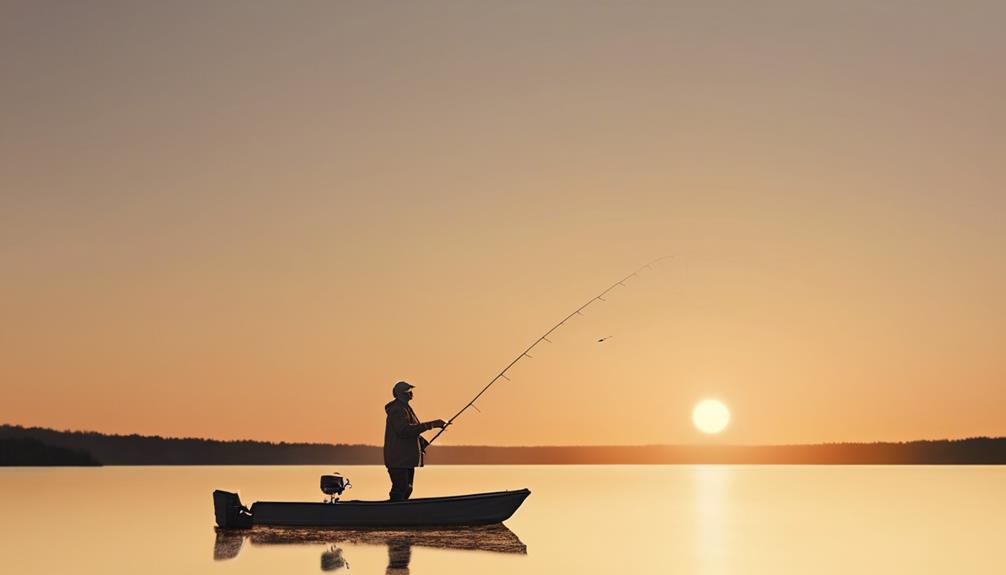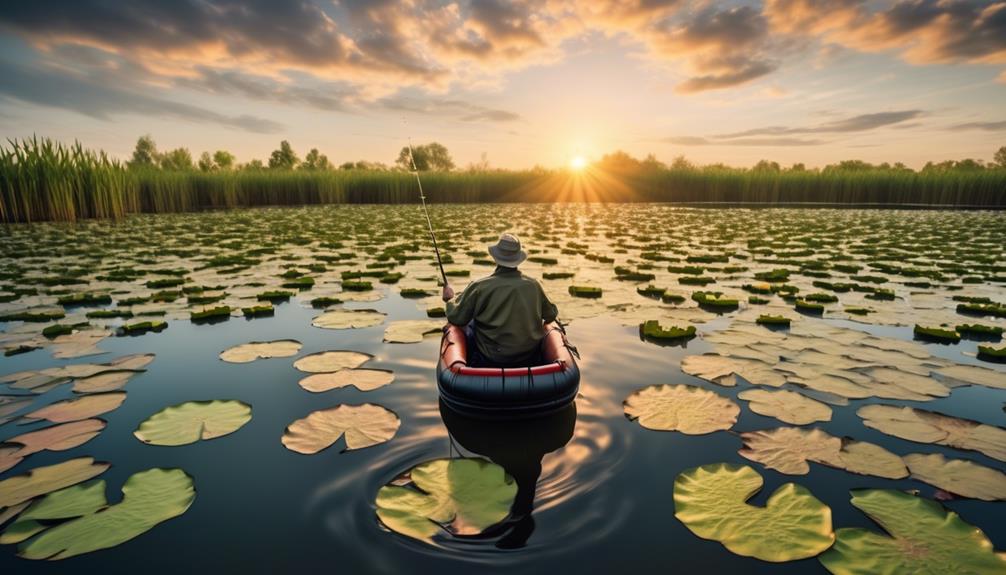You may not know that drop shot fishing for largemouth bass is a highly effective technique that can be used in a variety of conditions, from clear water to heavy cover. It requires finesse and precision, making it a favorite among seasoned anglers.
If you're looking to take your bass fishing game to the next level, mastering the ultimate drop shot techniques is essential. What makes this technique so effective? Stay tuned to discover the key components of successful largemouth bass drop shot fishing and how you can incorporate them into your own angling arsenal.
Setting Up the Drop Shot Rig
To set up the drop shot rig, first, tie a Palomar knot to attach the hook to the line. This knot provides a strong and reliable connection, essential for landing those big bass. Once the hook is secure, it's time to add the drop shot weight. Slide the weight onto the line, and then tie a small overhand knot to keep it in place. This setup allows the weight to move freely, giving your bait a natural presentation.
When it comes to leader length, consider the depth of the water you'll be fishing in. For shallower waters, a shorter leader of around 12 to 18 inches should suffice. In deeper waters, opt for a longer leader of 18 to 24 inches. This variation allows your bait to hover just above the lake bed, enticing the bass to strike.
Ensuring the proper leader length is crucial for enticing bites. It gives your bait the freedom to move with the water currents, making it more appealing to the bass. Additionally, the length of the leader determines how far off the bottom your bait will be, so adjusting it according to water depth can significantly impact your success.
Following these steps to set up your drop shot rig will give you a strong foundation for targeting largemouth bass. With the right leader length and drop shot weight, you'll be ready to entice those elusive big bass.
Choosing the Right Drop Shot Bait
When selecting the right drop shot bait, consider the natural forage in the bass's environment and choose a lure that closely mimics it. Bait selection is crucial in drop shot fishing as it can greatly affect your success in catching largemouth bass. When it comes to drop shot lure choices, it's essential to understand the behavior of the bass and the type of prey they commonly feed on.
For drop shot fishing, soft plastic baits are the most commonly used due to their lifelike movement in the water. Consider using baits such as small worms, minnows, or baitfish imitations. These types of baits can be very effective in mimicking the natural forage of the bass and enticing them to strike.
When it comes to color selection, it's important to match the hatch. If the bass's environment consists of small bluegill or shad, consider using green or silver colored baits to closely resemble their natural prey. Additionally, the size of the bait should also closely match the size of the natural forage in the bass's environment.
Experiment with different bait styles, colors, and sizes to determine which one works best in the specific body of water you're fishing. By closely mimicking the natural forage, you can increase your chances of enticing a largemouth bass to strike your drop shot rig.
Casting and Presentation Techniques
Consider adjusting your casting and presentation techniques to maximize the effectiveness of your drop shot rig when targeting largemouth bass. Achieving casting accuracy is crucial when drop shot fishing for largemouth bass. You want to place your bait precisely where the bass are holding, such as near structure or along the edge of weed beds. Practice casting to specific targets to improve your accuracy and increase your chances of enticing a strike.
When it comes to presentation, finesse is key. Largemouth bass can be finicky, especially in heavily pressured waters, so a finesse presentation can make all the difference. Use light line, small hooks, and subtle movements to create a natural and enticing presentation. The key is to make your bait appear as lifelike as possible, mimicking the movements of natural prey in the water.
Additionally, varying your presentation can help trigger more strikes. Experiment with different cadences and movements to see what the bass respond to best. Sometimes a slow, subtle shaking motion may be the ticket, while other times a more aggressive twitching action could be the key to triggering a strike. Pay close attention to how the bass are reacting and adjust your presentation accordingly.
Understanding Bass Behavior
Understanding largemouth bass behavior is essential for successful drop shot fishing. To increase your chances of a successful catch, it's important to grasp how bass behave in their natural habitat. Here are some key points to keep in mind:
- Bass Feeding: Largemouth bass are opportunistic feeders, meaning they'll often ambush prey when it comes within striking distance. Understanding their feeding habits can help you anticipate when they're most likely to be actively hunting for food. Pay attention to the type of prey available in the area you're fishing and adjust your drop shot presentation accordingly. By mimicking the movements of their natural prey, you can increase the likelihood of enticing a bite.
- Bass Habitat: Bass tend to favor certain types of habitat, such as submerged vegetation, rocky structures, and areas with varying depths. Knowing where bass are likely to be hiding can significantly improve your drop shot fishing success. Look for areas with cover, such as fallen trees, docks, or underwater rock formations. These are prime spots for bass to lurk and wait for an opportunity to strike.
Hooking and Playing Largemouth Bass
Having grasped the importance of understanding largemouth bass behavior for successful drop shot fishing, let's now focus on the crucial techniques for hooking and playing these elusive fish.
Proper hooking techniques are essential when targeting largemouth bass. When drop shot fishing, it's important to use the right hook size to ensure it's properly exposed, allowing for better hook sets. A popular choice is the 1/0 or 2/0 drop shot hook, which provides a good balance between strength and finesse. When setting the hook, use a smooth, steady motion to avoid pulling the hook out of the fish's mouth prematurely.
Understanding largemouth bass behavior and habitat preferences can greatly enhance your ability to play these fish effectively. Once hooked, it's crucial to play the fish properly to avoid break-offs. Largemouth bass are notorious for their powerful dives and head shakes, so it's important to maintain a steady rod angle and keep consistent pressure to tire the fish out. Always be prepared to adjust the drag on your reel to prevent line breakage. Additionally, avoid giving the bass slack line, as they can use any opportunity to throw the hook.
Adjusting for Depth and Structure
To effectively adjust for depth and structure when drop shot fishing for largemouth bass, assess the water column and the underwater terrain to determine the most suitable presentation. Understanding the depth variations and structure adjustments is crucial for a successful fishing experience. Here's how to make the necessary adjustments:
- Drop Shot Positioning: Pay close attention to the depth at which the largemouth bass are currently positioned. Use your fishfinder or depth gauge to locate the bass in the water column. Once you have a clear understanding of their depth, adjust your drop shot rig accordingly. This will ensure that your bait is presented at the optimal depth for enticing bites.
- Structure Targeting: Consider the underwater structure where largemouth bass tend to hide, such as submerged trees, rocks, or weed beds. Adjust your casting and retrieve to target these specific structures. By presenting your bait near these areas, you increase the chances of attracting bass that are seeking shelter or hunting for prey within the structure.
- Adapt to Depth Variations: As you move to different areas of the water body, be mindful of the depth variations. Adjust the length of your drop shot leader to match the changing depths. This adaptability will allow you to maintain consistent presentation and keep your bait within the strike zone, regardless of the water depth.
Tips for Fishing in Different Conditions

Consider adjusting your drop shot fishing techniques to accommodate different environmental conditions, maximizing your chances of a successful catch.
When it comes to weather conditions, adapt your approach accordingly. During overcast days or low-light conditions, bass may be more active and willing to roam, so you can experiment with casting further from the boat or shoreline. In contrast, on bright, sunny days, bass tend to seek shade and cover, so focus your efforts around structures like docks, overhanging trees, or submerged vegetation.
Additionally, pay attention to water clarity. In clear water, opt for more natural and subtle bait presentations, while in murky water, use brighter or more aggressively colored baits to grab the bass's attention.
The time of day also plays a crucial role. In the early morning and late afternoon, bass are often more active, so target shallower areas near drop-offs or points. As the sun rises higher, consider moving to deeper water or using a slower presentation to entice more cautious fish.
Furthermore, seasonal patterns influence bass behavior. In spring, bass are typically in shallow water for spawning, making it an ideal time for drop shot fishing in shallower areas. In summer, they may move to deeper, cooler waters, while in fall, they often feed more voraciously to prepare for winter.
Landing and Releasing Largemouth Bass
Adapting your drop shot fishing techniques to different environmental conditions also involves understanding how to effectively land and release largemouth bass after a successful catch. Proper fish handling and conservation practices are essential for the well-being of the bass population and the sustainability of the sport.
Here are a few key tips to ensure you're handling and releasing largemouth bass in a responsible manner:
- Minimize Handling: When you've successfully landed a largemouth bass, try to minimize the amount of time you handle the fish. Excessive handling can remove the protective slime coating from the fish, making it more susceptible to infections and diseases. Use wet hands or a wet towel when handling the bass to help preserve its slime layer.
- Use Proper Equipment: Equip yourself with the right tools for safe and efficient hook removal. A good pair of needle-nose pliers or hemostats can help you quickly and gently remove the hook, minimizing stress on the fish.
- Revive and Release: After unhooking the bass, take the time to properly revive it before release. Hold the fish upright in the water, allowing it to regain its strength and equilibrium. Once the bass is ready, gently release it back into the water, ensuring it swims away strongly.
Frequently Asked Questions
What Are the Best Drop Shot Fishing Techniques for Targeting Largemouth Bass in Heavily Weeded Areas?
When targeting largemouth bass in heavily weeded areas, the best drop shot fishing techniques involve using drop shot weedless tactics and finesse presentations. This will help you navigate the dense vegetation and entice the bass.
Are There Any Specific Drop Shot Rig Modifications or Adjustments That Can Be Made for Fishing in Deep Water Versus Shallow Water?
When fishing in deep water, you should consider making modifications to your drop shot rig, like using longer leaders and heavier weights. In shallow water, adjust by using shorter leaders and lighter weights for better results.
How Can Anglers Effectively Use Drop Shot Techniques in Areas With Strong Current or Tidal Flows?
To effectively use drop shot techniques in areas with strong current or tidal flows, adjust your weight and hook placement to keep your bait in the strike zone. Experiment with different sinker weights and leader lengths to find what works best.
Are There Any Special Considerations for Drop Shot Fishing in Murky or Stained Water Conditions?
When drop shot fishing in murky or stained water, it's important to adjust your techniques. Use brighter or contrasting colored baits to increase visibility. Consider a heavier weight to maintain contact with the bait in the water.
What Are Some Advanced Drop Shot Techniques for Targeting Trophy-Sized Largemouth Bass in Highly Pressured Waters?
You need to step up your game for targeting trophy-sized largemouth bass in highly pressured waters. Focus on Largemouth bass feeding patterns and refine your drop shot bait selection to entice those elusive big bites.
Conclusion
Now that you've learned the ultimate largemouth bass drop shot fishing techniques, it's time to hit the water and put your skills to the test.
Remember to set up your rig properly, choose the right bait, and adjust for different conditions.
Understanding bass behavior and using the right casting and presentation techniques will increase your chances of landing a big one.
And always remember to handle and release your catch with care.
Good luck out there!



